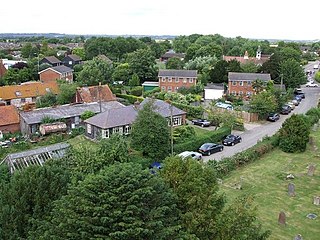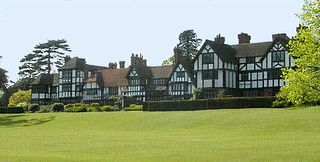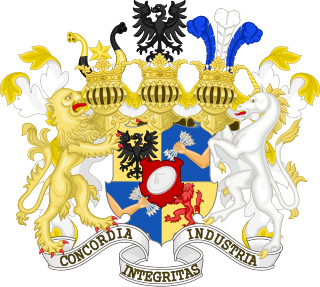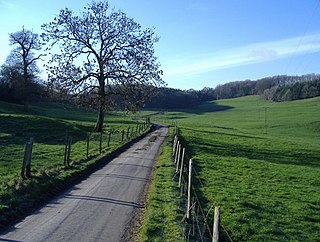

Aston Clinton House (also known as Green Park though referred to as simply Aston Clinton by the Rothschild family) was a large mansion to the south-east of the village of Aston Clinton in Buckinghamshire, England.


Aston Clinton House (also known as Green Park though referred to as simply Aston Clinton by the Rothschild family) was a large mansion to the south-east of the village of Aston Clinton in Buckinghamshire, England.
In 1851, Anthony Nathan de Rothschild bought the estate from a banker from Aylesbury. By 1853, he had completed the modernisation of Aston Clinton House and extensive estates in the area, with the help of the architect George Henry Stokes and the builder George Myers. From 1864 to 1877, the architect George Devey designed the cottages and the park gates [1] (he later transformed another Rothschild property, Ascott House). Old photographs of the house show a sprawling neo-Georgian/Italianate house with verandahs and a large porte-cochère. Many workers' cottages were built, and two schools and a village hall set up under Rothschild patronage.
On the death of Lady Louise de Rothschild in 1910, the house was bequeathed to her two daughters, Constance, Lady Battersea and Annie, The Hon. Mrs. Eliot Yorke, who shared it as a holiday home, spending a few weeks together there each summer. They developed horticulture in the gardens which became full of rare plants. Cyril Flower, 1st Baron Battersea contributed to the development of the gardens. [1]
In the First World War, like the adjoining Halton House and estate, Aston Clinton House was lent to the War Office, becoming in September 1914 the HQ of 21st Infantry Division. 21st Division was a "New Army" division, part of Kitchener's Army, and it was formed-up and trained on Rothschild land in Buckinghamshire, initially in Tring but in 1915 on the Halton and Aston Clinton estates. Four brigades of field artillery and one heavy battery received their advanced training in the grounds of Aston Clinton House in the spring and summer of 1915, including extensive gas offensive and defensive training. Final inspection of the division by Lord Kitchener occurred in August 1915 and the move to France took place from 2 to 13 September 1915.
In 1923, the Rothschilds sold the house to Dr Albert Edward Bredin Crawford for £15,000. [1]
At the start of the Second World War the house was the Green Park Hotel, but during the War the stables were used by EKCO, an electronics company from Southend-on-Sea, Essex, as its main headquarters and for radar research and development, and the main house was used as a hospital for war wounded. [2] It had been a boys' prep school (where Evelyn Waugh obtained his second post as a junior master in 1925)), followed by a further brief spell as a hotel. The main building was demolished between 1956 and 1958.
Buckinghamshire County Council then acquired the property with the proviso that it be used for educational purposes. Today the estate is used as a residential training centre for young people, operated by Kingswood Learning and Leisure Group. [3] The original ornamental features of the extended garden still remain, incorporated into the site now called Green Park. All that remain of the buildings of the estate are the stables, used as part of the training centre, and the lodge in Stablebridge Road.

Aston Clinton is a historic village and civil parish in the Vale of Aylesbury in Buckinghamshire, England. The village lies at the foot of the Chiltern Hills, between the Wendover and Aylesbury arms of the Grand Union Canal. Surrounding towns include Wendover to the south, Aylesbury to the west, and Tring to the east - across the nearby county border with Hertfordshire.

In the 19th century members of the English Rothschild family bought and built many country houses in the home counties, furnishing them with the art the family collected. The area of the Vale of Aylesbury, where many of the houses were situated, became known as "Rothchildshire". In the 20th century many of these properties were sold off with their art collections dispersed. Today only Eythrope House still belongs to the family; however, they still retain influence in how Ascott House and Waddesdon Manor are managed. In the loss of country houses in the 20th century only Aston Clinton was lost.

Royal Air Force Halton, or more simply RAF Halton, is one of the largest Royal Air Force stations in the United Kingdom. It is located near the village of Halton near Wendover, Buckinghamshire. The site has been in use since the First World War but is due to close by December 2027.

Halton is a small village and civil parish in the Buckinghamshire district of the ceremonial county of Buckinghamshire, England, located about two miles north of Wendover and five miles southeast of Aylesbury.

Eythrope is a hamlet and country house in the parish of Waddesdon, in Buckinghamshire, England. It is located to the south east of the main village of Waddesdon. It was bought in the 1870s by a branch of the Rothschild family, and belongs to them to this day.

Ascott House, sometimes referred to as simply Ascott, is a Grade II* listed building in the hamlet of Ascott near Wing in Buckinghamshire, England. It is set in a 32-acre / 13 hectare estate.

Mentmore Towers, historically known simply as "Mentmore", is a 19th-century English country house built between 1852 and 1854 for the Rothschild family in the village of Mentmore in Buckinghamshire. Sir Joseph Paxton and his son-in-law, George Henry Stokes, designed the building in the 19th-century revival of late 16th and early 17th-century Elizabethan and Jacobean styles called Jacobethan. The house was designed for the banker and collector of fine art Baron Mayer de Rothschild as a country home, and as a display case for his collection of fine art. The mansion has been described as one of the greatest houses of the Victorian era. Mentmore was inherited by Hannah Primrose, Countess of Rosebery, née Rothschild, and owned by her descendants, the Earls of Rosebery.

Wingrave is a village in Buckinghamshire, England, about four miles north east of Aylesbury and three miles south west of Wing.

Halton House is a country house in the Chiltern Hills above the village of Halton in Buckinghamshire, England. It was built for Alfred Freiherr de Rothschild between 1880 and 1883. It is used as the main officers' mess for RAF Halton and is listed Grade II* on the National Heritage List for England.

Baron Mayer Amschel de Rothschild was an English businessman and politician of the English branch of the Rothschild family. He was the fourth and youngest son of Hannah (Barent-Cohen) and Nathan Mayer Rothschild (1777–1836). He was named Mayer Amschel Rothschild, for his grandfather, the patriarch of the Rothschild family.

George Devey was an English architect notable for his work on country houses and their estates, especially those belonging to the Rothschild family. The second son of Frederick and Ann Devey, he was born and educated in London.

Gunnersbury Park is a park between Acton, Brentford, Chiswick and Ealing, West London, England. Purchased for the nation from the Rothschild family, it was opened to the public by Neville Chamberlain, then Minister of Health, on 21 May 1926. The park is currently jointly managed by Hounslow and Ealing borough councils. A major restoration project funded by the Heritage Lottery Fund was completed in 2018. The park and garden is Grade II listed.

Tring Park Mansion or Mansion House, Tring Park, is a large country house in Tring, Hertfordshire. The house, as "Tring Park", was used, and from 1872 owned, by members of the Rothschild family from 1838 to 1945.

The Rothschild banking family of England is the English branch of the Rothschild family. It was founded in 1798 by Nathan Mayer Rothschild (1777–1836), who first settled in Manchester before moving to London, England, which was then part of the Kingdom of Great Britain. He was sent there from his home in Frankfurt by his father, Mayer Amschel Rothschild (1744–1812). Wanting his sons to succeed on their own and to expand the family business across Europe, Mayer Amschel Rothschild had his eldest son remain in Frankfurt, while his four other sons were sent to different European cities to establish a financial institution to invest in business and provide banking services. Nathan Mayer Rothschild, the third son, first established a textile jobbing business in Manchester and from there went on to establish N M Rothschild & Sons bank in London.

Sir Anthony Nathan de Rothschild, 1st Baronet was a British financier and a member of the prominent Rothschild banking family of England.

The Wendover Arm Canal is part of the Grand Union Canal in England, and forms part of the British canal system. It is usually known as the Wendover Canal, but historically its builders referred to their branch canals as Arms, hence its historical name of Wendover Arm. It was planned as a feeder to carry water from springs near the town of Wendover in Buckinghamshire to the main line of the Grand Junction Canal at Bulbourne near Startops End in Hertfordshire, but when it opened in 1799 it was made navigable, as the extra cost of making it was so small. Water supplies from Wendover were found to be inadequate, and a series of reservoirs were built. A pumping station at Whitehouses was superseded by the Tringford pumping station in 1817; its steam engines were replaced by diesel engines in 1911 and then by electric pumps.

Kingscote Park is a Grade II listed house and country estate in Kingscote, near Tetbury, Gloucestershire, England. The original Kingscote Park was demolished in 1951. Both houses formed part of the manor of Kingscote which was held by the Kingscote family from the 12th century and is mentioned in the Domesday Book as 'Chingescote'.
Aston Hill Climb was a speed hill climb on public roads up Aston Hill near Aston Clinton in Buckinghamshire which was active from 1904 until 1925. The hill's enduring claim to fame came when Lionel Martin and his partner Robert Bamford achieved success with their self-built 'special' car, and hence named their fledgling car manufacturing business Aston Martin.

Chalfont Park, formerly known as Brudenells and Bulstrodes, is an English country house and estate near the village of Chalfont St Peter in Buckinghamshire.

Constance Flower, Baroness Battersea, also known as Lady Battersea, was a society hostess and philanthropist in London who established the Jewish Association for the Protection of Girls, Women and Children in 1885 and was prominent in the Temperance movement in the United Kingdom.